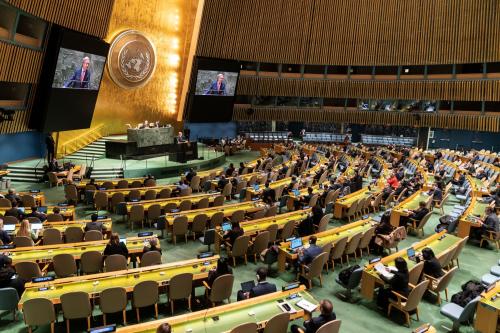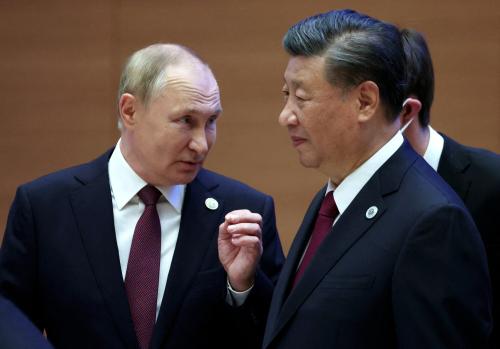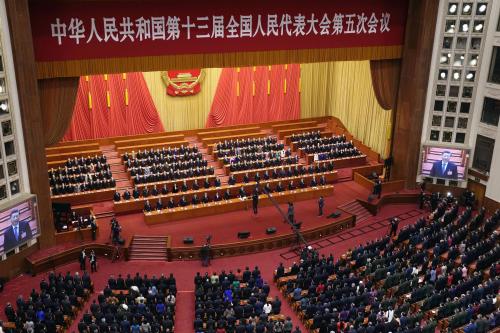Content from the Brookings Institution India Center is now archived. After seven years of an impactful partnership, as of September 11, 2020, Brookings India is now the Centre for Social and Economic Progress, an independent public policy institution based in India.
Brookings India Fellow Dr. Shamika Ravi, and Mr. R.N. Ravi, former Special Director, Intelligence Bureau of India, address questions on the economic and foreign policy priorities for the new government:
How will Narendra Modi govern? Is he the right person to lead India during this challenging time in its history?
Narendra Modi has won an overwhelming majority in the 2014 general elections of India. So one can say that he is the most popular political leader in India today. The electorate of India has given him a clear mandate to govern – by that token he is the right person for the job. He is riding on enormous aspirations and promises of the population. What he does with this great opportunity remain to be seen.
The data from Gujarat indicate that he will run an efficient government. But one must also appreciate that Gujarat is one state of the Indian union and to extrapolate from there would be simplistic. Maneuvering an entrenched Delhi bureaucracy will be a challenge. Redefining center-state relationship by devolving more powers to state Chief Ministers will be a fundamental structural change that Modi will attempt. His immediate focus will be on selecting a group of ministers and functionaries to run a decisive government and to kick start a stalled economy by giving confidence to domestic and foreign investors.
India’s economy has been battling its worst slowdown in a decade, struggling with weak growth and high inflation. However, one of Modi’s most notable successes as Chief Minister of Gujarat was his transformation of the state’s manufacturing base that contributed to economic growth.
What are the top things that the new government could do to rescue India’s economy from its slowest growth rates in a decade?
Growth is an outcome, not a policy tool. The top priority for the new government has to be governance. An efficient and fast moving governance structure is critical to restoring the dwindling investor confidence (both domestic and foreign investors) as well as arresting corruption. The new government, therefore, has to focus on bolstering infrastructure – both physical and financial – which is critical to realizing full growth potential. In the medium run, the government has to address some major structural changes such as: overhauling the restrictive and archaic labor laws, administrative reforms and devolving powers to state governments. Urban planning should be another key area of policy emphasis and implementation. This is, by no means, an exhaustive list of recommendations.
What is fundamental in the long run, however, is investment in health and education in India. These are basic requirements for any developing economy and specifically for a government that aspires to pull a large section of the population out of poverty.
What challenges will Modi face in translating this success to economic growth throughout India?
For growth to benefit all sections of the society/economy, the government has to overwhelmingly emphasize on efficient and fair governance. All sections of the society must have equal access to good governance and faith has to be restored in public institutions. Investments into health, education and infrastructure are critical.
Being areas of policy focus, some of these features of the Indian economy are also the key challenges to realizing the full growth potential:
- Poor health and nutritional standards in the population
- Low levels of literacy and skill
- Low capacity of legal infrastructure – leading to delays and high costs
- Poor urban planning making it difficult for cities to accommodate an ever increasing rural-urban migration as well as growing urban population
- All pervasive gender inequality
The new Modi government will be confronted with a series of international challenges that will have a direct bearing on its domestic policies and development agenda. What should the foreign policy priorities of the new government be?
Given the overwhelming mandate in the elections, the new government has to seize the opportunity and develop a strategic framework for its foreign policy. For long, India’s foreign policy has been largely ad-hoc and episodic, rather than strategic and consistent with long-term national interests. India’s foreign policy has to be well defined and compatible with its geostrategic assets and its core strengths. Given the size of the country and its robust plural democratic traditions, India is critical to regional and global peace and prosperity.
India’s relation with many of its neighbors is defined by a palpable mutual trust deficit. Overcoming this should be a strategic priority. Within this context, Modi’s decision to invite the SAARC (South Asian Association for Regional Cooperation) leaders at his swearing-in ceremony is a welcome first step. It reconfirms Modi’s position as stated in his election campaign, to build India’s relations with its neighbors on the basis of equality and mutual respect.
Peace, stability and growth of robust democracy in the neighborhood are in the interest of India and the region. India’s foreign policy towards its neighbors has to be framed distinctly and should be commensurate with it being the geo-strategic and geo-cultural center of gravity of the region.
Despite its existence for 29 years, SAARC as a regional multilateral body is far from achieving its founding vision of economic integration. India should play the lead role in fulfilling this vision.
Within this broader framework, India’s bilateral relations with its neighbors could be defined as following:
Bangladesh crucially impacts India’s northeast which is home to 45 million people. Given the unsatisfactory level of trust between the two countries, notwithstanding positive strides in mutual relationship during the current Bangladesh’s regime, priority has to be given to augment the mutual trustgoing beyond individual leaders. Towards this, Modi’s move to invite the leader of the opposition party in Bangladesh, besides the Prime Minister – who is an official invitee – is a significant and welcome shift. Moving forward, the outstanding issues of the Land Boundary Agreement, sharing of the Teesta River, water and transit connectivity between India’s mainland and its northeast region are priorities. Enhancing overall connectivity between the two countries and institutionalizing the existing informal commercial and sociological links are of long-term mutual benefit.
Pakistan: The main obstacle to improving India’s bilateral relations with Pakistan is the absence of a strong democratic state in Pakistan. Negotiating across multiple power centers not always aligned with each other is a fundamental impediment. Pakistan’s apathy in dealing with terrorist threats to India originating from its soil and a reasonable perception that Pakistan uses terrorism as an instrument of its policy to weaken India will continue to undermine any positive tangible traction in the bilateral relationship. India needs to explore with Pakistan opportunities and areas where the interests of the two countries converge. Serious attempts have to be made to overcome the bitter legacy of history, which will require seeking reconciliation between the two ideas of Pakistan and India.
Afghanistan: India has several security and strategic interests in Afghanistan where it enjoys significant leverage. India is the largest regional investor in Afghanistan and has undertaken several projects including training and capacity building of its security personnel. It has high stakes in a peaceful and stable Afghanistan. Its foreign policy priority, therefore, has to be directed towards achieving these goals.
Sri Lanka: India’s foreign policy towards Sri Lanka has to be in sync with its larger national interests and international obligations in the Indian Ocean region. It has to be freed from the stifling limitations of ethnic interests and affiliations with due regard to their democratic aspirations. India will continue insisting on adherence to the 13th amendment to Sri Lanka’s constitution; however, its broader engagement should be in consonance will its geo-strategic imperatives.
Nepal: India and Nepal share an overwhelming ethnic and cultural cosmology. However, this has not been translated into a strong strategic relationship between the two countries. There is convergence of huge mutual strategic interests between the two countries, and the new government’s priority should be to define and build on these interests.
Myanmar: So far Myanmar has been in the attention-shadow of India’s foreign policy. Its engagement with Myanmar has been limited to its implications for insurgency in India’s Northeast and increasing China’s footprints in the region. It is, however, India’s gateway to Southeast Asia and crucial to the success of its Look-East policy. With the emergence of a democratic state in Myanmar, how so ever fragile, it offers greater scope for broadening mutual relations.
China: The India-China relation suffers a legacy of mutual bitterness and deep suspicion following the 1962 war. Resolving the border dispute should be a priority in improving bilateral relations with China. Besides, many of the rivers of India originate in Tibet. Diversion or controlling the flows of these rivers will have very serious and adverse environmental and economic impacts on India. India has to formulate a coherent foreign policy vis-à-vis China with due regard to its legitimate national interests and international obligations in the subcontinent, Southeast Asia, and the Indian Ocean. Given China’s asymmetric superiority in economic power, India must calibrate and foster trade and commerce links that can reduce the current balance of trade.
In an effort to mend tensions between the U.S. and India, President Barack Obama recently congratulated India on its national election and said the U.S. will work closely with India’s next government. How can the U.S. be a stronger partner on defense and economic issues?
While preserving its strategic autonomy, India must build its relations with the US on the shared values of liberal plural democracy, and common concerns of threats to these values from terrorism.
America’s perceived indulgence of Pakistan casts its shadows on India-US relations. The partnership will be strengthened if the US is seen factoring some of the India’s critical security concerns in its relations with Pakistan. India-US relations are crucial to the stability and prosperity of the Indo-Pacific region. It will be crucial to the success of President Obama’s ‘pivot to Asia’ policy.
While India’s procurement of defense equipments from the US has been expanding over the years and there has been quantum increase in joint exercises between the defense forces of the two countries, partnership should extend to co-operation in the field of cyber-security and technology sharing.
Image Source: Maciej Dakowicz



Commentary
Op-edEconomic & Foreign Policy Priorities for Modi’s Government
May 25, 2014